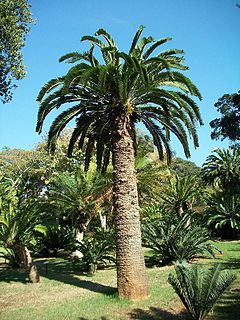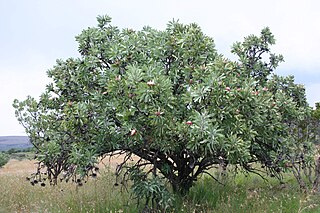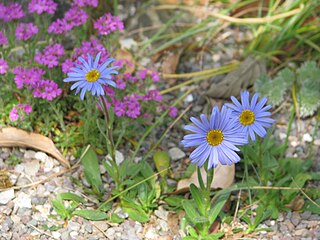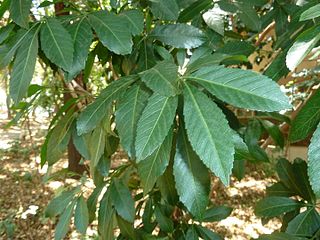
Thunbergia is a genus of flowering plants in the family Acanthaceae, native to tropical regions of Africa, Madagascar and southern Asia. Thunbergia species are vigorous annual or perennial vines and shrubs growing to 2–8 m tall. The generic name honours the Swedish naturalist Carl Peter Thunberg (1743-1828).

Thunbergia mysorensis, the Mysore trumpetvine or lady's slipper vine, is a species of flowering plant in the family Acanthaceae. A woody-stemmed evergreen, this vine is native to southern tropical India. The specific epithet mysorensis is derived from the city of Mysore.

Thunbergia alata, commonly called black-eyed Susan vine, is a herbaceous perennial climbing plant species in the family Acanthaceae. It is native to Eastern Africa, and has been naturalized in other parts of the world. It is found in Cerrado vegetation of Brazil and Hawaii, along with eastern Australia and the southern USA in the states of Texas and Florida, Colombia, and in Puerto Rico.

Encephalartos woodii, Wood's cycad, is a rare cycad in the genus Encephalartos, and is endemic to the oNgoye Forest of KwaZulu-Natal, South Africa. It is one of the rarest plants in the world, being extinct in the wild with all specimens being clones of the type. The specific and common name both honour John Medley Wood, curator of the Durban Botanic Garden and director of the Natal Government Herbarium of South Africa, who discovered the plant in 1895.

Protea caffra, native to South Africa, is a small tree or shrub which occurs in open or wooded grassland, usually on rocky ridges. Its leaves are leathery and hairless. The flower head is solitary or in clusters of 3 or 4 with the involucral bracts a pale red, pink or cream colour. The fruit is a densely hairy nut. The species is highly variable and has several subspecies.

Veronica polita, or grey field-speedwell, is a herbaceous flowering plant species in the plantain family Plantaginaceae. It has hairy stems, is either prostrate or ascending, with dull green leaves that are one of petiolate, serrate, ovate (rounded) and usually wider than long. The flowers are small and bright blue. The plant has solitary axillary peduncles that are shorter or slightly longer than the leaves. It is native to Eurasia, possibly including the British Isles, western Asia, northern Africa, and North America, but has been introduced into suitable habitats worldwide as a weed of cultivation. It is susceptible to downy mildew disease caused by the oomycete species Peronospora agrestis.

Gardenia thunbergia is a sturdy large shrub or small tree endemic to the southern and eastern regions of South Africa and neighbouring territories such as Eswatini. It grows largely in forest or on forest margins, occurring in the Eastern Cape, Natal and Transkei in South Africa. It is densely twiggy and rigid with smooth light-grey bark, and is horticulturally valuable, being easy to grow as a strong hedge, but more usually as a specimen plant, striking in appearance and long lived. The abundant and extremely fragrant flowers are about 70 mm in diameter with long tubes only accessible to the proboscises of nocturnal hawkmoths. The leaves are smooth, shiny, whorled and entire, and clustered at the ends of branchlets. The fruit is oval, hard, woody and fibrous, about 80 mm long and about 40 mm in diameter, light grey with small raised white spots and if not eaten by large browsers or elephant, will remain on the tree for years. Its common names include forest gardenia, mutarara, tree gardenia, white gardenia and wild gardenia. In Afrikaans it is variously known as buffelsbol, stompdoring, or wildekatjiepiering.

The Natal hinge-back tortoise, also known as Natal hinge-backed tortoise or Natal hinged tortoise, is a species of tortoise in the family Testudinidae which is restricted to eastern southern Africa to a relatively small area around the borders of Mozambique, South Africa, and Eswatini.
(Orachrysops ariadne), the Karkloof blue, is a species of butterfly in the family Lycaenidae.

Agapanthus praecox is a popular garden plant around the world, especially in Mediterranean climates. It is native of Natal and Cape of Good Hope in South Africa, local names include agapant, bloulelie, isicakathi and ubani. Most of the cultivated plants of the genus Agapanthus are hybrids or cultivars of this species. It is divided into three subspecies: subsp.praecox, subsp. orientalis and subsp. minimus.

Areas of forest which grow in KwaZulu-Natal, South Africa mostly on south facing slopes in higher rainfall areas, and along the humid coastal areas. Different types of forest can be identified by their species composition which depends mostly on the altitude, latitude and substrate in which they grow. South facing slopes are favourable for the development of forest as they are more shaded, and therefore cooler and retain more moisture than the northern slopes. The extra moisture on the south slopes is not only favoured by forest trees, but also helps to prevent or subdue wildfires. Fires can also be blocked by cliff faces and rocks or boulders on these slopes, and by streams or rivers at the base of the slopes. The coastal regions are conducive to forest formation, because of high rainfall and humidity which are favoured by forest trees and also help to prevent or subdue fires. The rivers of the coastal areas are also broader than further inland, which may often prevent fires from spreading long distances, and fires generally burn uphill and therefore more often away from areas at low altitude.

The Maputaland-Pondoland-Albany Hotspot (MPA) is a biodiversity hotspot, a biogeographic region with significant levels of biodiversity, in Southern Africa. It is situated near the south-eastern coast of Africa, occupying an area between the Great Escarpment and the Indian Ocean. The area is named after Maputaland, Pondoland and Albany. It stretches from the Albany Centre of Plant Endemism in the Eastern Cape Province of South Africa, through the Pondoland Centre of Plant Endemism and KwaZulu-Natal Province, the eastern side of Eswatini and into southern Mozambique and Mpumalanga. The Maputaland Centre of Plant Endemism is contained in northern KwaZulu-Natal and southern Mozambique.

Deinbollia oblongifolia is a shrub or small tree in the family Sapindaceae. It is commonly known as the dune soap-berry and is found in coastal vegetation from the Eastern Cape of South Africa, through KwaZulu-Natal to southern Mozambique and Swaziland. It is named after Peter Vogelius Deinboll (1783-1876), a Danish botanist and plant collector.

Mikania natalensis, the Natal Mikania, is a plant in the family Asteraceae, and is native to Africa.

Euclea natalensis, the Natal guarri, is a dioecious African plant species of the family Ebenaceae. It occurs from Ethiopia and Somalia in the north, southwards to the Western Cape, South Africa. Its hirsute, leathery leaves have an opposite arrangement, and the flower sprays grow from the leaf axils. The spherical fruit appear from October to June.

Encephalartos natalensis, the Natal cycad or giant cycad, is a species of cycad that is endemic to the Qumbu and Tabankulu areas of the northern part of the Eastern Cape, and through most of KwaZulu-Natal. The number of mature individuals of this species is declining and the International Union for Conservation of Nature has assessed its conservation status as being "near threatened".

Felicia rosulata is a hairy, perennial, herbaceous plant of up to 30 cm (1 ft) high, that is assigned to the daisy family. It has a rosette of elliptic 8 cm × 2 cm leaves with 3–5 veins, and long, hairy stalks, each topped with one floral head consisting of about thirty middle blue ray florets encircling many yellow disc florets. It can be found in the mountains of Lesotho, eastern South Africa and Swaziland.

Allophylus natalensis, commonly known as the dune false crowberry or dune false currant, is a species of plant in the genus Allophylus native to south-eastern Africa.

Protea laevis, also known as the smooth-leaf sugarbush, is a flowering shrub that belongs within the genus Protea.

Thunbergia atriplicifolia, the Natal primrose, is a species of flowering plant in the family Acanthaceae, native to South Africa and Eswatini. It is a favored browse of the steenbok.























